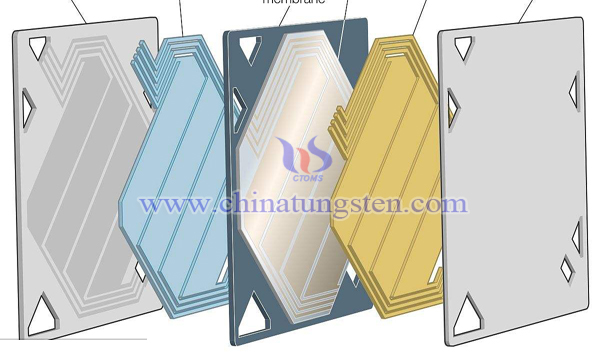Silicotungstic Acid - Silica Polyvinylidene Fluoride Proton Exchange Membrane
- Details
- Category: Tungsten Information
- Published on Sunday, 25 August 2019 12:35
As the fifth generation fuel cell, proton exchange membrane fuel cell (PEMFC) not only has the general advantages of fuel cell, but also has the outstanding advantages of high energy conversion, low temperature start-up, no leakage of electrolytic cell, no corrosion, long life and high specific power. Therefore, the research of PEMFC has become the mainstream of all kinds of fuel cell research.

As the core material of proton exchange membrane fuel cell, proton exchange membrane (PEM) plays the role of selective proton (H+) from cathode conductor to anode, and it also blocks fuel and oxidant. The performance of proton exchange membranes determines the performance of fuel cells.
The preparation method of the silicotungstic acid-silica polyvinylidene fluoride proton exchange membrane comprises the following steps:
(1)weigh a certain amount of polyvinylidene fluoride and dissolve in dimethylimide to make a solution, in which 15-19 g of dimethylimide is needed per gram of polyvinylidene fluoride. Heat the oil bath of the solution to 50-70 ℃, and stir it for 1-3 hours to make solution A.
(2)Solution A was poured onto a clean glass plate and vacuum dried at 60-90 ~℃ to form PVDF film. The film was placed in 6-8 mol/L sodium hydroxide solution, treated in 60-80 ~℃ oil bath for 8-10 hours, then rinsed repeatedly with deionized water to neutral, and dried at 100-120 ~℃ to form a modified PVDF film.
(3)Solution B was prepared by dissolving a certain amount of modified PVDF film in a mixture of dimethylidene and water (10:1 volume ratio of dimethylidene to water), in which 15-19 g of mixed solution was required per gram of membrane.
(4)Solution B is heated to 80-95 ℃ and stirred for 1 to 3 hours at this temperature, then the temperature drops to 60-75 ℃ to form solution C.
(5)According to the weight ratio of modified PVDF to sodium tungstate and silicon tetrachloride in solution C, 75-85 phr, 15-10 phr and 10-5 phr respectively, sodium tungstate and silicon tetrachloride were weighed. Sodium tungstate and silicon tetrachloride were added into solution C in turn, and then stirred for 1-3 hours before cooling to room temperature to form uniform solution D.
(6)The vacuum oil bath of solution D is heated to 110-130 degrees C and stirred for 1 to 2 hours at that temperature until the water evaporates completely. The obtained solution is cooled to room temperature to form a uniform solution E.
(7) Solution E was poured onto PTFE glass plate and dried in vacuum to form a film. The film thickness was controlled at 0.1-0.2 mm and the vacuum drying temperature was 90-100 ℃. The required proton exchange membrane of Silicotungstic Acid-Silica PTFE was obtained.
Silicotungstic acid-silica polyvinylidene fluoride proton exchange membranes have smaller alcohol permeability than traditional Nafion membranes, better alcohol resistance, simple preparation process, lower cost than Nafion membranes, and are easy to industrialize, which will promote the development of direct methanol fuel cells.
- Tungsten Oxide Manufacturer & Supplier, Chinatungsten Online: www.tungsten-oxide.com
- Tungsten News & Prices of China Tungsten Industry Association: www.ctia.com.cn
- Molybdenum News & Price: news.molybdenum.com.cn
- Tel.: 86 592 5129696; Fax: 86 592 5129797; Email: sales@chinatungsten.com



 sales@chinatungsten.com
sales@chinatungsten.com